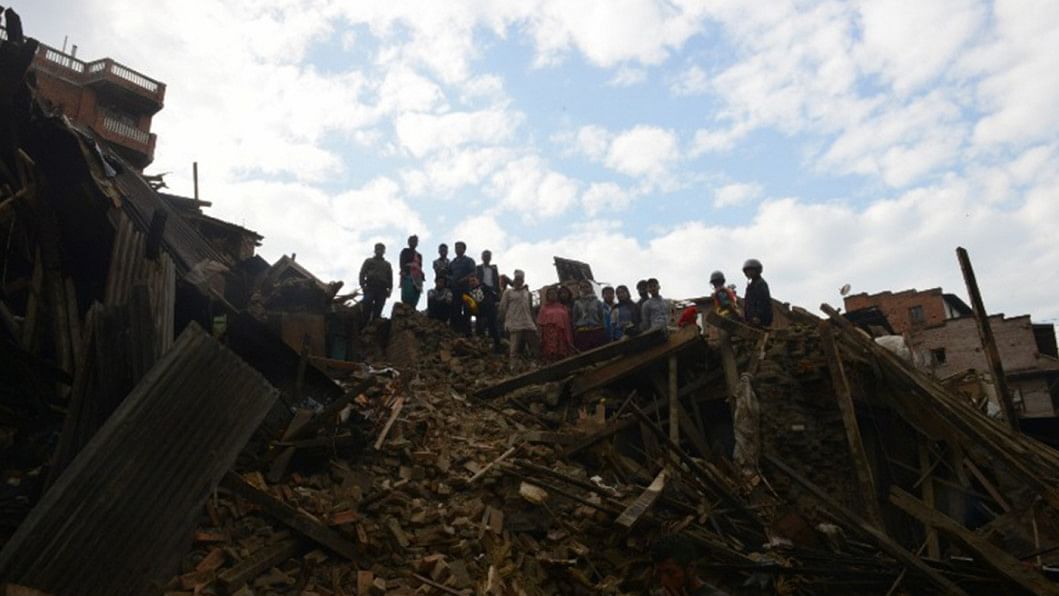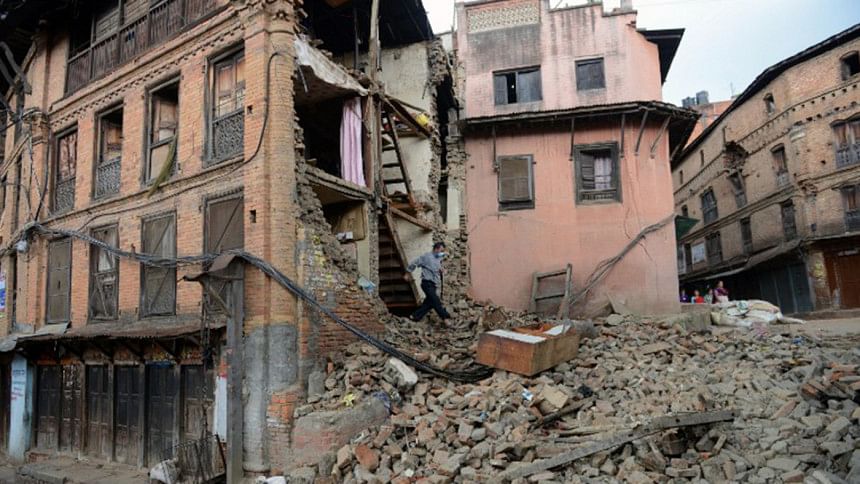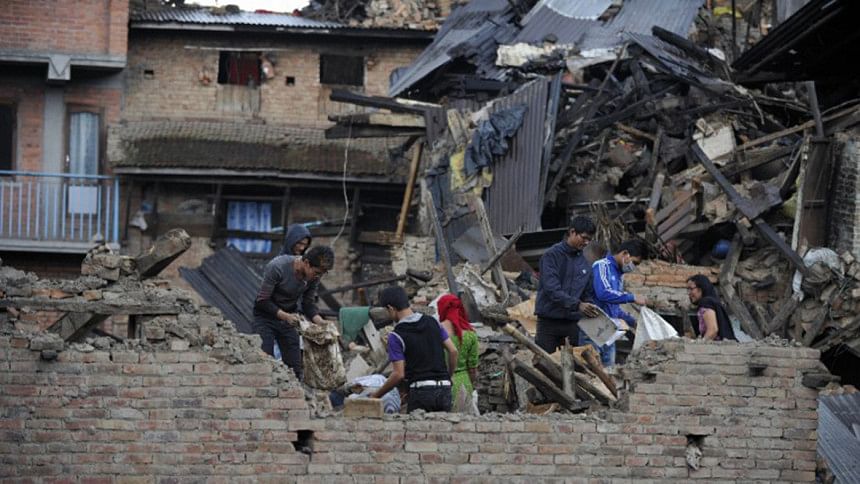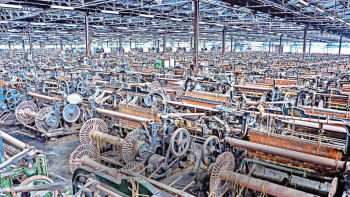'Most Nepal troops' in quake effort

Nine out of 10 Nepalese troops are said to be involved in search and rescue operations, as the country pleads for more foreign aid to deal with a massive earthquake that killed 4,000 people.
Almost the entire army and police has joined the quake effort, officials say.
China, India, the UK and US are among those sending aid from abroad. Nepal says it needs everything from blankets and helicopters to doctors and drivers.
Some 200 climbers stranded by the quake on Mount Everest are being rescued.
About 60 of the climbers had been brought to safety by helicopters on Monday, according to Tulsi Gautam, the chief of Nepal's tourism agency.
He told the BBC that helicopters were only ferrying two people at a time because of the risk of flying at such a high altitude. The climbers had been unable to leave the mountain because of avalanches triggered by the tremors.
The quake, which struck on Saturday, is now known to have injured at least 7,000 people. Vast tent cities have sprung up in Nepal's capital, Kathmandu, for those displaced or afraid to return to their homes.

Several aftershocks have been reported - the latest on Monday night. Across the country, thousands are camping outside for the third night. There are shortages of water, food and electricity, and fears of outbreaks of disease.
Almost every soldier and police officer in Nepal is involved in search and rescue work, a spokesman for the home ministry, Lakshmi Prasad Dhakal, told the BBC.
Meanwhile, an army spokesman told the Associated Press news agency that 90% of the country's 100,000 troops are taking part in the quake effort.
The Nepalese government's Chief Secretary, Lila Mani Poudyal, said his country was short of medical teams and relief materials, including "tents, dry goods, blankets, mattresses and 80 different medicines".
"We don't have the helicopters that we need or the expertise to rescue the people trapped," he said. The need for doctors would grow as more survivors were pulled from the rubble, Poudyal added.

Dozens of people are also reported to have been killed by the earthquake in neighbouring China and India.
Both countries have sent emergency teams to Nepal, along with Pakistan, which said it was dispatching four C130 transport planes carrying a 30-bed hospital. Other countries, including Britain, Australia and New Zealand are also contributing aid, alongside international agencies.
However, congestion at Kathmandu's airport has caused delays, with Indian TV reporting that an Indian relief flight was forced to turn back.
United Nations World Food Programme spokeswoman Elisabeth Byrs told AFP that the agency planned "a large, massive operation".
At the scene: Sanjoy Majumder, at a temporary camp in Lainchaur, Kathmandu
This camp had been set up on a playground and even now there are quite a few children playing. But it no longer resembles a safe place. There's rubbish everywhere, paper plates, wrappers and plastic glasses are strewn all over.
"It's getting quite bad," says one man who is here with his wife and four daughters. "We've been here for three days and we've been living on instant noodles. There's nothing else to eat."
His house is not badly damaged, but he is adamant that he will not go home despite the challenging conditions in the camp.
"We've heard all these rumours about more earthquakes and aftershocks. We will not leave this place, not for a while."
Officials have warned that the number of casualties could rise as rescue teams reach remote mountainous areas of western Nepal.
New drone footage shows the extent of devastation from the #NepalEarthquake: http://t.co/Jlg6Qphr6G https://t.co/1xDDv1BMvb
— CNN International (@cnni) April 28, 2015
Many communities close to mountainsides are believed to have suffered significant damage.
Matt Darvas, a spokesman for aid agency World Vision, told the BBC that entire villages of up to 1,000 people could have been buried by rock falls.
In Dhading district, 80km (50 miles) west of Kathmandu, people were camped in the open, the hospital was overflowing, the power was off and shops were closed, Reuters news agency reported.
"There is nobody helping people in the villages. People are dying where they are," AB Gurung, a Nepalese soldier in Dhading, told Reuters.
A senior official in Gorkha district, at the earthquake's epicentre, told AP he had heard of 70% of houses being destroyed.

Among the villages affected are some inhabited by Tibetans, many of whom have sought refuge in Nepal. Bridim, north of Kathmandu, is reported to have been virtually flattened.
On Mount Everest, clear weather on Monday allowed helicopters to rescue foreign climbers and their Nepalese guides who had been stranded by a huge avalanche.
At least 18 people have been killed by avalanches on the mountain.
China has meanwhile announced a halt to all spring expeditions along the north face of Mount Everest, state media reports.
The longer term cost of rebuilding in Nepal has been put at $5bn (£3bn) by US-based consultancy, IHS - around 20% of its GDP.
The UN children's agency saidsnearly one million children in Nepal urgently needed humanitarian assistance as they were particularly vulnerable.
Dead or missing foreigners
Australia: 549 Australians registered as travelling in Nepal, 200 confirmed safe
Bangladesh: 50 nationals, including members of the country's under-14 girls' football team, evacuated. No information on exact number of nationals in Nepal
China: Four nationals dead in Kathmandu, Xinhua news agency reports
Colombia: Seven nationals missing
France: French authorities have located 1,098 nationals, but another 674 are still not in touch
India: Five killed in Nepal
UK: Several hundred Britons believed to be in Nepal. No reports of casualties but some missing.
US: Four Americans killed
Victims from other countries include a dead Estonian national and a Japanese man killed.

 For all latest news, follow The Daily Star's Google News channel.
For all latest news, follow The Daily Star's Google News channel. 



Comments